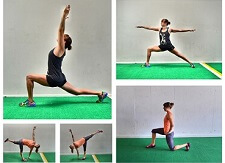- Home
- Knee Pain Diagnosis
- Above Knee Pain
Pain Above Knee
Written By: Chloe Wilson, BSc(Hons) Physiotherapy
Reviewed by: KPE Medical Review Board
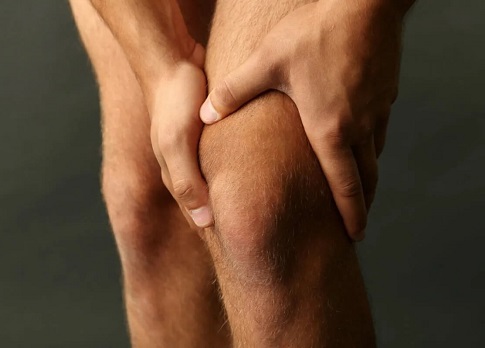
Pain above the knee is a common problem that can affect people of any age.
A great deal of force goes through the upper knee as we walk, run, squat, kneel, kick and jump so it’s no wonder the knee and thigh gets sore!
Most cases of top of knee pain are due to an injury, overuse, repetitive activities or wear and tear. There may be a problem in the bones, soft tissues or an underlying medical condition.
Pain above the knee can vary in intensity and type, ranging from intermittent to continuous, and may present as a dull ache or sharp, catching pain. Top of knee pain is often accompanied by swelling above the knee, and can limit movement and affect the overall function of the joint.
What Causes Above Knee Pain?
Here we will look at the most common causes of top of knee pain and how to tell which is causing your knee and thigh pain, and then we’ll go on to look at how to treat them.
1. Quadriceps Tendonitis
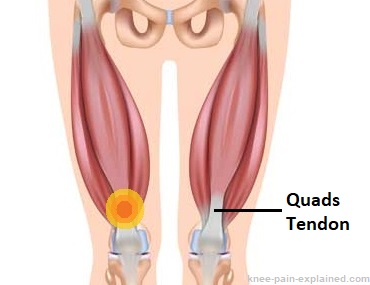
The most common cause of pain above the knee and in the lower thigh is quadriceps tendonitis.
With quadriceps tendonitis, there is inflammation and degeneration of the tendon that attaches the quads muscles to the top of the kneecap.
Quadriceps tendonitis usually causes tenderness and pain just above the knee cap that gets worse with activity.
There may be some swelling above the knee and knee stiffness when you first get up which eases off as you move around.
You can also get hamstring tendonitis which causes pain in the back of the thigh, which typically causes pain in the back of the hip region, but can cause posterior knee pain.
Tendonitis is typically an overuse injury often associated with sports requiring quick, repetitive movements e.g. basketball & volleyball, overtraining, muscle imbalance and biomechanical problems.
You can find out all about this common cause of pain right above the knee, including the causes, symptoms, diagnosis and treatment options in the Quadriceps Tendonitis or Hamstring Tendonitis sections.
2. Knee Bursitis
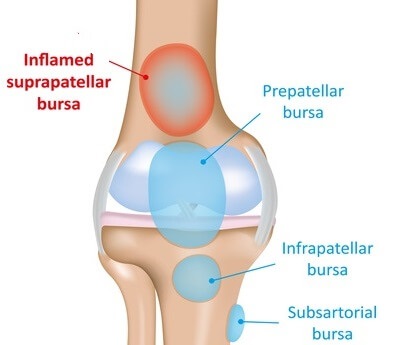
The most common cause of swelling and pain above the knee is bursitis.
With knee bursitis there is inflammation of one of the fluid-filled sacs that sit between the bones and soft tissues around the knee.
There are a number of different knee bursa that can get inflamed but the ones most likely to cause swelling and pain above the kneecap are suprapatellar bursitis and prepatellar bursitis.
Common symptoms of knee bursitis include a soft pocket of swelling above the knee, which may fluctuate in size, and an achy pain on top of knee.
Repetitive actions such as kneeling, kicking and squatting often cause knee bursitis and it is often more common in people with muscle tightness or who have experienced previous knee injuries.
You can find out all about the common causes of top of knee pain and swelling from bursitis including the best treatment options in the knee bursitis section.
3. Knee Arthritis
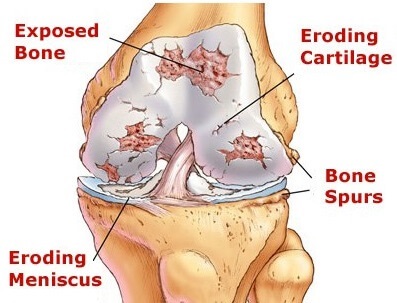
The most common cause of top of knee pain in people over 60 is knee osteoarthritis where there is wear and tear and degeneration of the knee cartilage and bones.
Knee arthritis causes a nagging toothache type pain on top of the knee, particularly when fully bending or straightening the knee, and in activities where there is a lot of weight going through the joint e.g. squatting or going up and down stairs.
Arthritis knee symptoms often fluctuate and a common feature is knee stiffness first thing in the morning.
Pain above the knee from arthritis is caused by damage and degeneration of the knee cartilage which leads to the formation of bone spurs in the joint. This is usually related to aging but is also linked with genetics, previous knee injuries, and obesity.
You can find out everything you need to know about arthritis pain above the knee and the best treatment options including which supplements and foods are best in the knee arthritis section.
4. Iliotibial Band Syndrome
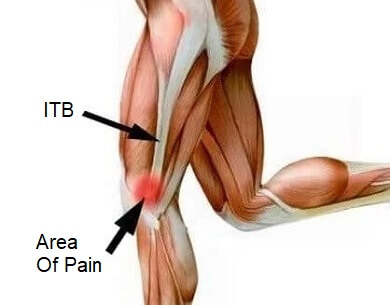
The most common cause of pain on the outside of the top of the knee is iliotibial band syndrome, frequently affecting runners.
With iliotibial band syndrome, aka ITBS, there is irritation and inflammation of the thick band that runs down the outer leg and attaches just above the knee.
Iliotibial band syndrome causes pain above the outer side of the knee, which is usually worse when running, particularly when the heel strikes the floor, and going down stairs. There may be some mild swelling on the side of the knee and a popping/snapping sensation as you bend the knee.
Top of knee pain from iliotibial band syndrome often affects long distance runners, particularly after suddenly increasing training levels, and is more likely if you have any muscle imbalance, flat feet or knee bone spurs.
You can find out all about ITBS, how it causes top outside knee pain and how to treat it in the iliotibial band syndrome section.
5. Muscle Strain
If your pain above the knee came on very suddenly during activity, there is a high chance you have pulled one of the thigh muscles. Muscle strains usually occur when a muscle is suddenly overstretched or overloaded which causes some of the muscle fibres to tear.
Thigh strains usually cause sudden pain above the knee, often associated with a popping or snapping sensation at the time of injury. Bruising and swelling above the knee may develop over 24-48 hours. Weakness is common which can limit functional activities such as going up and down stairs, walking and getting up from a chair.
The most common muscle strain to cause pain in the leg above the knee is a pulled quads muscle which causes front of thigh pain, whereas hamstring strains cause back of thigh pain.
You can find out all about top of knee pain from muscle strains and how to treat them in the quadriceps strain or hamstring strain sections.
6. Patellofemoral Pain Syndrome
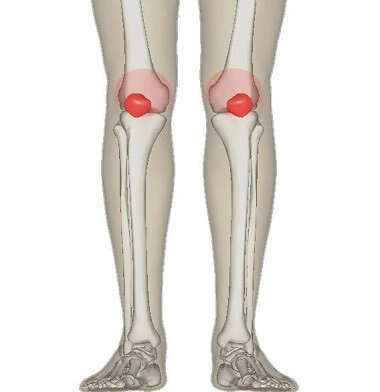
Another common cause of top of knee pain is patellofemoral pain syndrome, more commonly known as Runners Knee. Don’t be fooled by the name though, it’s just as likely to affect office workers as runners!
Patellofemoral pain syndrome develops gradually from excess stress on the cartilage that lines the back of the kneecap.
Runner’s knee typically causes an ill-defined pain on top of the knee that fluctuates and typically gets worse during long periods of activity, coming down stairs or when you first get up. You may also notice some grating/grinding noises with leg movement.
Muscle weakness and tightness is a common cause of top of knee pain from runner’s knee, particularly if you have flat feet, or wide hips.
You can find out all about how patellofemoral pain syndrome causes pain above the knee and the best ways to treat it in the Runners Knee Section.
Other Possible Causes
Other possible causes of pain above the knee include:
- Knee Bone Spurs: Outgrowths of excess bone can cause hard lumps and sharp, catching pain on top of the knee
- Deep Vein Thrombosis (DVT): A blood clot in the deep veins of the leg can cause pain above the knee along with swelling and warmth
- Nerve Compression/Sciatica: Compression of the sciatic nerve can lead to radiating pain from the lower back down the leg, causing pain above the knee and in the thigh
- Femoral Stress Fracture: a small crack or fracture in the femur bone, typically caused by repetitive stress or overuse of the thigh muscles and bones. Causes thigh pain on top of knee, especially during weight-bearing activities
- Peripheral Artery Disease (PAD): Reduced blood flow to the muscles of the leg due to PAD can cause pain above the knee during physical activity, known as claudication
- Spinal Stenosis: Narrowing of the spinal canal can cause nerve compression and result in radiating pain in leg above knee
- Perthes Disease: A childhood condition where the blood supply to the head of the thigh bone is disrupted, causing hip pain in the leg above the knee
- Contusion: Impact or injury to the soft tissues and blood vessels in the thigh can cause bruising and localised pain above the knee
Pain Above Knee Treatment
Treatment for top of knee pain will depending on what is causing the problem but usually includes:
- PRICE: Protect the area from further injury e.g. knee brace, crutches; Rest from aggravating activities to allow healing; Ice applied regularly helps reduce pain above knee and inflammation; Compression to reduce inflammation e.g. tubigrip; Elevating the knee above hip height helps to reduce swelling
- Medication: OTC painkillers and anti-inflammatories can help control the swelling and pain above the knee
- Stretches: stretching out the thigh and knee muscles can help reduce pressure and friction through the knee structures, reducing pain on top of the knee. A combination of knee stretches, quads stretches and hamstring stretches usually works best
- Strengthening Exercises: Improving the strength, stability and control of the knee helps to reduce the load through the joint and thus reduce pain in the leg above the knee. A combination of knee strengthening, quads strengthening and hamstring strengthening exercises usually works best
- Knee Braces: There are various knee braces can be worn to help support and improve the stability of the knee, and knee straps are particularly effective for off-loading structures e.g. with tendonitis
- Injections: Corticosteroid injections can help to reduce top of knee pain and inflammation in the short term as part of your treatment
- Orthotics: special inserts to wear in your shoes that help to correct foot position, particularly fallen arches, and reduce the forces going through your knee
- Surgery: While most cases of top of knee pain will respond to conservation (non-surgical) treatment, in some cases e.g. with severe knee arthritis or a quads tendon rupture, surgery may be advised
With any case of pain above the knee, the first step is to get any pain and swelling under control and protect the leg from further damage. Once you have done that, you can then start on specific treatment for your above knee pain:
- Quads Tendonitis Treatment
- Knee Bursitis Treatment
- Knee Arthritis Treatment
- ITB Syndrome Treatment
- Muscle Strain Treatment
- Runners Knee Treatment
What Is Causing Your Top Of Knee Pain?
So as we’ve seen here, there are lot of possible causes of pain above the knee, each of which present slightly differently:
- Sharp Pain Right Above Knee: knee bursitis, bone spurs, torn hamstring and nerve damage can all cause sharp pain top of knee
- Burning Pain Above Knee: a burning pain on top of the knee is usually due to nerve damage, peripheral artery disease or knee bursitis
- Top Outside Knee Pain: above knee pain on the outer side of the leg is usually caused by iliotibial band syndrome or a lateral quadriceps strain
- Inside Leg Pain Above Knee: top inside knee pain is usually due to a medial quads strain
- Pain Above Knee When Bending: is usually associated with runners knee, bursitis or knee arthritis
- Pain Above Knee When Squatting: is often a sign of quadriceps tendonitis, runners knee, iliotibial band syndrome or quads strain
- Top Of Knee Pain Running: pain above the knee cap after running is usually caused by quadriceps tendonitis (pain right above knee), ITB Syndrome (top outside knee pain) or hamstring tendonitis (at the back of the knee)
- Weakness & Pain Above Knee: if your top of knee pain is accompanied by weakness, it is likely due to quadriceps tendonitis, a quads strain, nerve damage or knee arthritis
- Strange Noises Above The Knee: if there are unusual noises coming from the painful area above your knee when you move it may be due to a muscle strain (popping at time of injury), ITB syndrome (snapping sensation), runners knee (grinding sensation) or knee bone spurs (clicking/locking sensations)
- Pain Above The Back Of The Knee: pain above the knee on the back of the thigh is usually due to hamstring tendonitis or a hamstring strain
If inflammation and swelling is a problem alongside your knee pain, check out the swelling above the knee article.
If none of these is sounding like your problem, or you would like more help working out what is causing your pain above the knee, check out the knee pain diagnosis section.
Alternatively, if you have pain in another area of your knee, check out the following articles:
- Front Knee Pain
- Pain Below Knee
- Pain Behind The Knee
- Outer Knee Pain
- Inner Knee Pain
- Knee Cap Pain
- Calf Pain
- Knee Pain At Night
- How To Do Stairs With Knee Pain
Page Last Updated: 29/09/23
Next Review Due: 29/09/25


